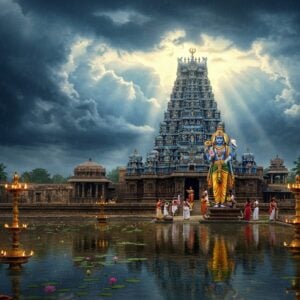
The Dashavatara, or the ten principal avatars of Lord Vishnu, hold a special place in Hindu mythology. Revered as the preserver within the Hindu Trinity, these incarnations symbolize cosmic order and moral guidance. Understanding each avatar offers profound insights into their cultural and religious importance across the Indian subcontinent.
Understanding Dashavatara
In Hindu philosophy, an ‘Avatar’ is the divine descent of God into the earthly realm to restore dharma, or cosmic order. The term ‘Dashavatara’ combines ‘Dasha’ meaning ten, and ‘Avatar’ meaning incarnation. The concept aligns with the cyclical nature of time in Hindu cosmology. Each avatar represents divine intervention at critical points in cosmic history, helping maintain balance in the universe and ensuring the triumph of good over evil.
The Order and Significance of the Dashavatara
The Dashavatara unfolds in a specific sequence, each avatar with a unique narrative and symbolic meaning. This divine lineage begins with Matsya, the fish, and culminates with Kalki, the prophesied warrior. This order reflects the evolution of life and consciousness according to Hindu scriptures. Each avatar plays a crucial role in maintaining cosmic balance and guiding humanity towards righteousness.
-
Matsya (The Fish)
Matsya, the first avatar, embodies salvation, rescuing humanity and sacred texts from a devastating flood. This narrative parallels flood myths across various cultures, highlighting universal themes of renewal and the preservation of knowledge. Matsya is revered as the progenitor of life and a symbol of divine grace.
Learn more about the significance of rituals and ceremonies in Hindu tradition.
-
Kurma (The Tortoise)
Kurma, the second avatar, represents stability and resilience. During the churning of the cosmic ocean (Samudra Manthan), Kurma patiently supports Mount Mandara on his back, enabling the devas and asuras to obtain the nectar of immortality. This act symbolizes perseverance amidst chaos and the pursuit of divine wisdom.
-
Varaha (The Boar)
Varaha, the boar, restores cosmic balance by rescuing Earth from the depths of the ocean where it was hidden by the demon Hiranyaksha. This act of divine intervention signifies the triumph of good over evil and the restoration of order. Explore the Varaha Lakshmi Narasimha Swamy Temple: History, Significance, and Darshan Guide and Your Complete Visit Guide: Timings, Location & Travel Tips.
-
Narasimha (The Man-Lion)
Narasimha, the fearsome man-lion, protects his devotee Prahlada from the tyrannical demon Hiranyakashipu. His unique form, transcending human and animal boundaries, represents divine power and the destruction of evil. Narasimha embodies unwavering devotion and the protection of the righteous. Learn about Narasimha and other divine avatars: Exploring the Divine Trinity’s Significance.
-
Vamana (The Dwarf)
Vamana, the dwarf Brahmin, cleverly subdues the arrogant demon king Bali through humility and divine strategy. His three strides encompass the three realms, asserting divine sovereignty. Vamana teaches the importance of humility and adherence to dharma.
-
Parashurama (The Warrior with an Axe)
Parashurama, a powerful warrior sage, eliminates corrupt rulers to restore justice and righteousness. He embodies righteous anger and the necessity of upholding dharma, even through force.
-
Rama (The King of Ayodhya)
Rama, the noble prince and king, is the embodiment of dharma, duty, and virtue. His life story, depicted in the epic Ramayana, serves as a timeless example of ideal kingship, loyalty, and sacrifice.
-
Krishna (The Divine Statesman and Charioteer)
Krishna, the divine statesman and charioteer in the Mahabharata, guides humanity with wisdom and love. His teachings in the Bhagavad Gita offer profound insights into dharma, karma, and the path to self-realization. Delve deeper into the symbolism of Krishna: Krishna’s Flute: Symbolism of Music, Divinity, and Devotion and Krishna’s Ten Avatars (Dashavatara) Explained: Krishna’s Significance. Create your own sacred space: Create a Krishna Altar: A Simple Guide for Your Home.
-
Buddha (The Enlightened One)
Buddha, the enlightened sage, emphasizes compassion, non-violence, and the pursuit of spiritual liberation. His inclusion in the Dashavatara reflects the integration of Buddhist philosophy within certain Hindu traditions. Immerse yourself in the devotional aspects of Krishna: Krishna in Art: Paintings, Drawings, and Rangoli – A Celebration and Krishna Bhajans: A Journey into Devotion and Love.
-
Kalki (The Future Warrior)
Kalki, the prophesied final avatar, is destined to appear at the end of Kali Yuga, the current age of decline. He represents hope, renewal, and the ultimate triumph of righteousness over evil.
Honoring the Dashavatara with Poojn.in
Poojn.in offers a wide selection of sacred items to help you honor and worship the Dashavatara. From intricately crafted idols to essential puja supplies, we provide everything you need to create a reverent atmosphere in your home.
- Idols and Murtis: Find beautifully crafted depictions of each avatar, from Laddu Gopal to Radha Krishna, perfect for your home altar. Smaller sizes are also available.
- Puja Essentials: Enhance your worship with nail polish for puja, pure camphor, and incense sticks.
- Sacred Accessories: Explore our range of Rudraksha malas and other items like copper vessels and puja thalis.
- Herbal Offerings: Offerings such as Haritaki (Harad) can be incorporated into your puja rituals.
Visit Poojn.in today to discover our complete collection and enhance your spiritual journey.
Embracing the Teachings of the Dashavatara
The Dashavatara offers profound insights into Hindu philosophy and the cyclical nature of time. Each incarnation imparts valuable lessons about dharma, righteousness, and the eternal struggle between good and evil. By understanding and reflecting upon these divine narratives, we can deepen our connection to our spiritual heritage and find inspiration for living a life of purpose and meaning.

